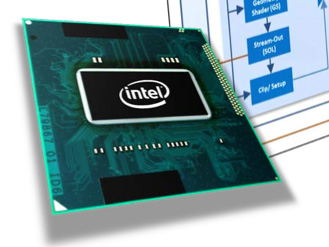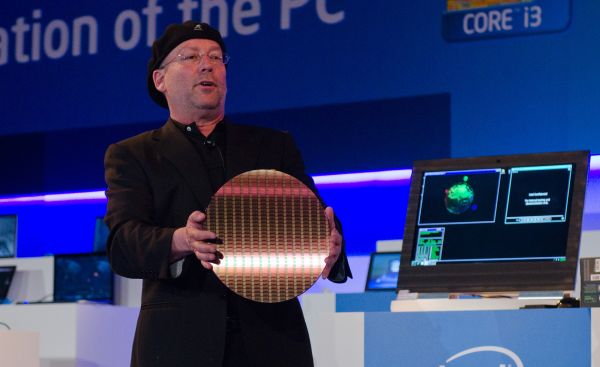Intel's Ivy Bridge Architecture Exposed
by Anand Lal Shimpi on September 17, 2011 2:00 AM EST- Posted in
- CPUs
- Intel
- Ivy Bridge
- IDF 2011
- Trade Shows
Five years ago Intel announced its ambitious tick-tock release cadence. We were doubtful that Intel could pull off such an aggressive schedule but with the exception of missing a few months here or there tick-tock has been a success. On years marked by a tick Intel introduces a new manufacturing process, while tock years keep manufacturing process the same and introduce a new microprocessor architecture. To date we've had three tocks (Conroe, Nehalem, Sandy Bridge) and two ticks (Penryn, Westmere). Sampling by the end of this year and shipping in the first half of next year will be Intel's third tick: Ivy Bridge.

Ivy Bridge (IVB) is the first chip to use Intel's 22nm tri-gate transistors, which will help scale frequency and reduce power consumption. As we already mentioned, mobile Ivy Bridge will be the first Intel CPU to bring four cores into a 35W TDP.
At a high level Ivy Bridge looks a lot like Sandy Bridge. It's still a monolithic die that features an integrated GPU. The entire die is built at 22nm, continuing Intel's march towards truly addressing integrated graphics performance. Ivy Bridge won't get rid of the need for a discrete GPU but, like Sandy Bridge, it is a step in the right direction.

Intel hasn't announced die size but transistor count has increased to approximately 1.4 billion (layout). This is up from 1.16 billion in Sandy Bridge, a 20.7% increase. With perfect scaling a 22nm Sandy Bridge die would be 47.3% the size of a 32nm die. Even with the increase in transistor count, it's a good bet that Ivy Bridge will be noticeably smaller than Sandy Bridge.
Motherboard & Chipset Support
Ivy Bridge is backwards compatible with existing LGA-1155 motherboards, although there will be a new chipset for Ivy Bridge and new motherboards to enable some features (e.g. PCI Express 3.0, native USB 3.0). The new chipset family falls under the 7-series banner. We'll see Z77, Z75, H77, Q77, Q75 and B75 available at or around launch.
| Chipset Comparison | ||||||||
| Z77 | Z75 | H77 | Z68 | P67 | H67 | |||
| CPU Support |
IVB LGA-1155 |
IVB LGA-1155 |
IVB LGA-1155 |
SNB/IVB LGA-1155 |
SNB/IVB LGA-1155 |
SNB/IVB LGA-1155 |
||
| CPU Overclocking | Yes | Yes | No | Yes | Yes | No | ||
| CPU PCIe Config |
1 x16 or 2 x8 or 1 x8 + 2 x4 PCIe 3.0 |
1 x16 or 2 x8 PCIe 3.0 |
1 x16 PCIe 3.0 |
1 x16 or 2 x8 or 1 x8 + 2 x4 PCIe 3.0 |
1 x16 or 2 x8 PCIe 3.0 |
1 x16 PCIe 3.0 | ||
| Processor Graphics Support | Yes | Yes | Yes | Yes | No | Yes | ||
| Intel SRT (SSD caching) | Yes | No | Yes | Yes | No | No | ||
| RAID Support | Yes | Yes | Yes | Yes | Yes | Yes | ||
| USB 2.0 Ports (3.0) | 14 (4) | 14 (4) | 14 (4) | 14 | 14 | 14 | ||
| SATA Total (Max Number of 6Gbps Ports) | 6 (2) | 6 (2) | 6 (2) | 6 (2) | 6 (2) | 6 (2) | ||
| PCIe Lanes | 8 (5GT/s) | 8 (5GT/s) | 8 (5GT/s) | 8 (5GT/s) | 8 (5GT/s) | 8 (5GT/s) | ||
As I mentioned above, Ivy Bridge finally supports USB 3.0 natively. The consumer 7-series chipsets feature 14 total USB ports, 4 of which are USB 3.0 capable. The CPU itself features 16 PCIe (1x16, 2x8 or 1x8 + 2x4) gen 3 lanes to be used for graphics and/or high performance IO. You will only see Gen 3 speeds on qualified motherboards. It's technically possible on 6-series motherboards but guaranteed on 7-series motherboards. The Z77 and H77 chipsets will support Intel's Smart Response Technology (SRT, aka SSD caching) which is a Z68 exclusive today.
SATA and chipset-attached PCIe slots haven't changed. Overclocking is supported on all Z-chipsets, while the H-chipset doesn't. All chipsets support Intel's HD Graphics, which is a departure from the Sandy Bridge mess where P67 didn't.










97 Comments
View All Comments
JonnyDough - Monday, September 19, 2011 - link
4-5 year old GPU? Heh, bud...most hardware takes years to develop. And the HD3000 series may be a bit dated but it makes even the XBox 360 look weak in comparison. Hardly dismal.moozoo - Saturday, September 17, 2011 - link
Does its GPU support double precision under OpenCL? i.e. cl_khr_fp64Does Trinity?
Ryan Smith - Saturday, September 17, 2011 - link
We don't have solid details on either one, but don't count on it. The reasons we don't see full FP64 support on non-halo GPUs are still in play for CPUs.Galcobar - Saturday, September 17, 2011 - link
Perhaps I'm missing something in the acronyms, but the table and text seems to disagree on the availability of SSD caching.The text states "All of the 7-series consumer chipsets will support Intel's Rapid Storage Technology (RST, aka SSD caching)."
The table, however, puts No under the Z75 column for Intel SRT (SSD caching).
As I understand things, you need RST (software) to support SRT (bound to the motherboard), but without SRT you don't get SSD caching.
Anand Lal Shimpi - Saturday, September 17, 2011 - link
Fixed :) SRT is only on the Z77/H77, not the Z75.Take care,
Anand
mlkmade - Saturday, September 17, 2011 - link
I know its really early to be talking about this cause ivy won't be out for awhile..but what about what amounts to be "ivyb-e" ? I'm sure details are very scarce...but will it follow the desktop path (both s1155) and be socket compatible? in this case s2011? if ivyb-e is socket compatible with sb-e...that'd be great..but by then all the chipset problems would be fleshed out huh..buy a new mono anywayAnand Lal Shimpi - Saturday, September 17, 2011 - link
I would hope so, but as of now there is no IVB-E on the roadmaps so anything I'd say here would be uninformed and speculative at this point :-/Take care,
Anand
ltcommanderdata - Saturday, September 17, 2011 - link
Does Ivy Bridge finally allow the IGP and QuickSync engine to be available even with a discrete GPU plugged in for both mobile and desktop without resorting to specific chipsets (ie. limited to the high-end chipset) or third-party software (relying on motherboard makers and OEMs to deal with Lucid)? WIth the IGP being OpenCL and DirectCompute capable, even if you have the latest Quad SLI/Crossfire setup it would be useful to have the IGP help out in GPGPU tasks.And it's interesting that with AMD introducing a beefier form of SMT with two full integer cores, Intel decided not to similarly increase hardware resource duplication to expand Hyperthreading. Instead Intel is focusing on improving single threaded performance by making sure a single thread can use all the resources if Hyperthreading is not needed. Seeing most software isn't making use of 8 simultaneous threads, focusing on making 4 threads (1 per core) work as fast as possible does make sense.
Meegulthwarp - Saturday, September 17, 2011 - link
"As we've already seen, introducing a 35W quad-core part could enable Apple to ship a quad-core IVB in a 13-inch MacBook Pro." Here is to hoping that someone other than apple will also ship a decent 13-inch with a quad.Other than that great insight, I really hope the GPU on IVB will be half way useable. I think we've hit a point where CPU performance is more than adequate for 95% of consumers. Now just need to up the GPU performance and get power down so we can use our laptops on battery all day. I'm more than happy with my 2 year old C2D CPU performance but want battery life, hugely tempted with AMD's A6-3400M. But with Bulldozer looming I think I may hold back for 6 months.
Anand Lal Shimpi - Saturday, September 17, 2011 - link
I hope so too, I simply used Apple as an example because it has migrated to quad-core in every member of its MBP family with the exception of the 13-inch. I've updated the statement to be a bit more broad :)Take care,
Anand